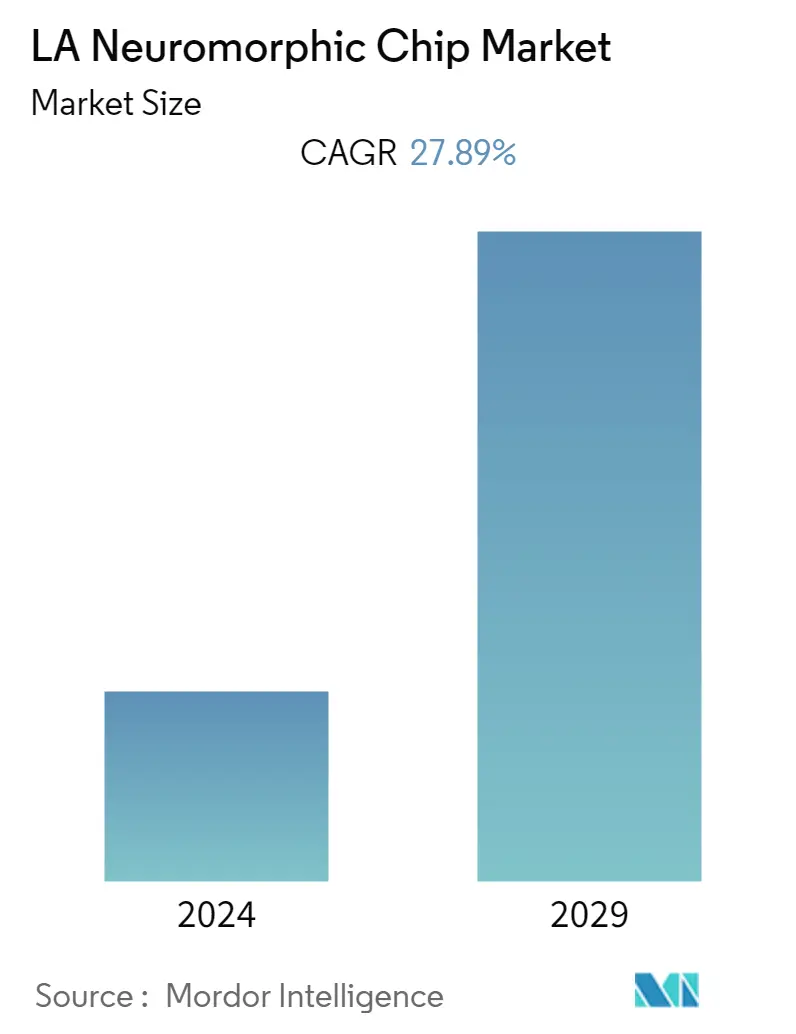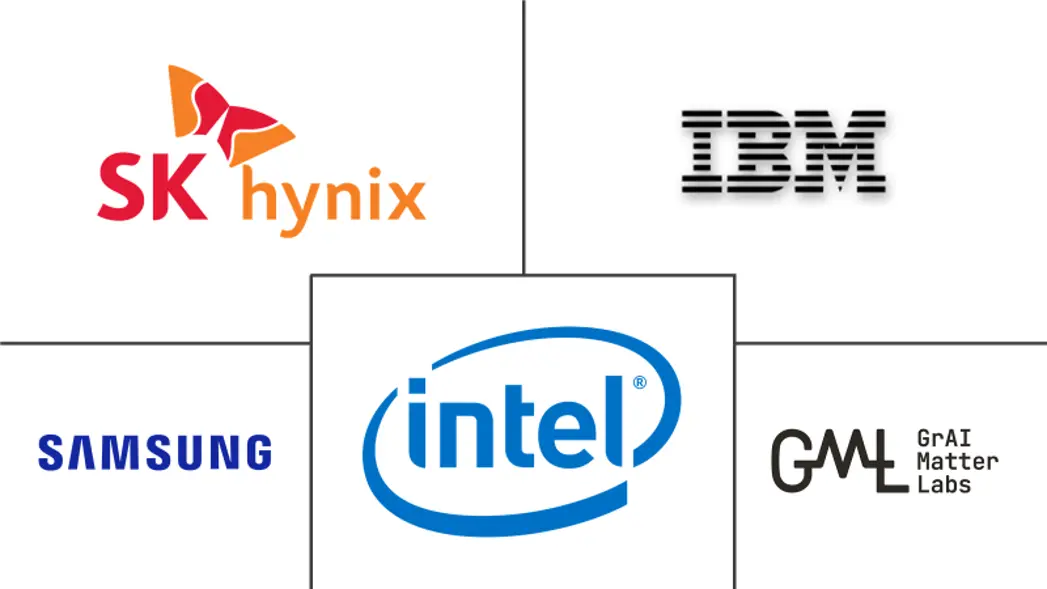Market Size of LA Neuromorphic Chip Industry

| Study Period | 2019 - 2029 |
| Base Year For Estimation | 2023 |
| Forecast Data Period | 2024 - 2029 |
| Historical Data Period | 2019 - 2022 |
| CAGR | 27.89 % |
| Market Concentration | Medium |
Major Players
*Disclaimer: Major Players sorted in no particular order |
Latin America Neuromorphic Chip Market Analysis
Latin America's neuromorphic chip market was valued at USD 0.19 billion in 2020 and is projected to reach USD 0.83 billion by 2026, at a CAGR of 27.89%. The demand for neuromorphic chips increases with the mounting demand for IoT and data analytics. The motivation behind designing these chips is to build a platform for running large-scale, real-time simulations to aid neuroscience research. As a result, innovation in processor architecture is being seen with more interest by governments, research institutes, and business entities, thereby evolving into significant developments.
- Neuromorphic is a specific brain-inspired ASIC that implements the Spiked Neural Networks (SNNs). It has an object to reach the massively parallel brain processing ability in tens of watts on average. The memory and the processing units are in single abstraction (in-memory computing). This leads to the advantage of dynamic, self-programmable behavior in complex environments.
- Companies, such as BrainChip Holdings Ltd, are forming multiple partnership activities to utilize neuromorphic chips in curbing the spread of COVID-19. In May 2021, BrainChip Holdings Ltd partnered with precision immunology company Biotome Pty Ltd to develop a fast, accurate COVID-19 antibody test. The companies will explore how the Akida neural processor could improve the accuracy and information quality of the antibody tests while Biotome is developing by providing advanced AI capacity at the point of care.
- Neuromorphic chips can be designed digitally, analog, or in a mixed way. Analog chips resemble the characteristics of the biological properties of neural networks better than digital ones. In the analog architecture, few transistors are used for emulating the differential equations of neurons. Therefore, theoretically, they consume lesser energy than digital neuromorphic chips. Besides, they can extend the processing beyond its allocated time slot. Thanks to this feature, the speed can be accelerated to process faster than in real-time. However, the analog architecture leads to higher noise, which lowers the precision.
- Digital ones, on the other hand, are more precise compared to analog chips. Their digital structure enhances on-chip programming. This flexibility allows artificial intelligent researchers to accurately implement various kinds of an algorithm with low-energy consumption compared to GPUs. Mixed chips try to combine the advantages of analog chips, i.e., lesser energy consumption, and the benefits of digital ones, i.e., precision.
- Neuromorphic architectures address challenges, such as high-power consumption, low speed, and other efficiency-related bottlenecks prevalent in the von Neumann architecture. Unlike the traditional von Neumann architecture with sudden highs and lows in binary encoding, neuromorphic chips provide a continuous analog transition in the form of spiking signals. Neuromorphic architectures integrate storage and processing, getting rid of the bus bottleneck connecting the CPU and memory.
Latin America Neuromorphic Chip Industry Segmentation
The Latin America Neuromorphic Chip Market is segmented by End-User Industry (Financial Services and Cybersecurity, Automotive, Industrial, Consumer Electronics).
Neuromorphic chips are digitally processed analog chips with a series of networks similar to human brain networks. These chips contain millions of neurons and synapses to augment self intelligence, irrespective of pre-installed codes in normal chips. As a special kind of chips, these are highly capable of manipulating data received through sensors.
LA Neuromorphic Chip Market Size Summary
The Latin American neuromorphic chip market is poised for significant growth, driven by the increasing demand for artificial intelligence and the miniaturization of integrated circuits in response to consumer preferences for compact devices. Neuromorphic chips, which mimic the brain's neural networks, offer advantages in energy efficiency and parallel processing, making them ideal for applications in IoT, data analytics, and smart technologies across various industries such as automotive, electronics, and medical. The automotive sector, in particular, is a key driver of market expansion, as premium car manufacturers invest heavily in achieving advanced levels of vehicle autonomy, necessitating the use of AI-powered neuromorphic chips for efficient data processing and real-time decision-making.
The market is characterized by a niche presence of a few key players, including BrainChip Holdings Ltd, Intel Corporation, and SynSense AG, who are actively engaging in strategies like collaboration, product innovation, and research and development to strengthen their market position. Despite the initial phase of development, neuromorphic chips are emerging as a promising alternative to traditional AI accelerators such as GPUs and FPGAs, offering superior performance and energy efficiency for both AI inference and training. The market's medium concentration indicates a competitive landscape where top players are focusing on expanding their market share through strategic partnerships and technological advancements.
LA Neuromorphic Chip Market Size - Table of Contents
-
1. MARKET INSIGHTS
-
1.1 Market Overview
-
1.2 Industry Attractiveness - Porter's Five Forces Analysis
-
1.2.1 Bargaining Power of Suppliers
-
1.2.2 Bargaining Power of Consumers
-
1.2.3 Threat of New Entrants
-
1.2.4 Threat of Substitutes
-
1.2.5 Intensity of Competitive Rivalry
-
-
1.3 Industry Value Chain Analysis
-
1.4 Emerging Use Cases for Neuromorphic Chips
-
1.5 Analysis of the Impact of COVID-19 on the Market
-
LA Neuromorphic Chip Market Size FAQs
What is the current LA Neuromorphic Chip Market size?
The LA Neuromorphic Chip Market is projected to register a CAGR of 27.89% during the forecast period (2024-2029)
Who are the key players in LA Neuromorphic Chip Market?
Intel Corporation, SK Hynix Inc., International Business Machines Corporation, Samsung Electronics Co. Ltd and GrAI Matter Labs are the major companies operating in the LA Neuromorphic Chip Market.

